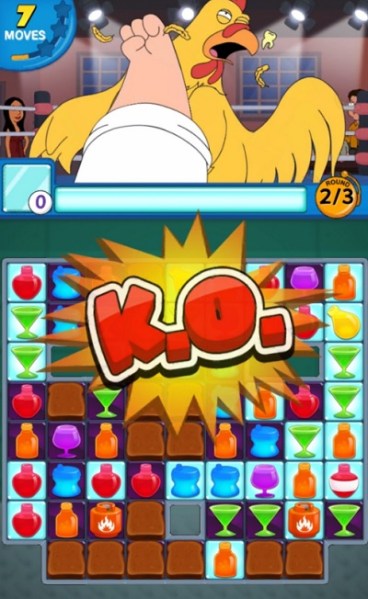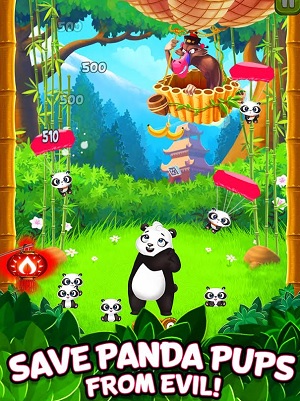
Above: Family Guy: Another Freakin’ Mobile Game
GB: Is there an approach to creativity that you take at the highest level? You have seasoned teams doing what they’re good at, but with such a large enterprise, you want to make sure that every game coming out is a hit. Is there anything you try to standardize in your process?
DeWolfe: Absolutely. The team working on a game has to be passionate about the mechanics and the IP. We’ll typically say, “We think we have access to these IP. Is there anything special you’d do with any of them?” They’ll go back to the drawing board amongst themselves. It could be two or five or 10 people. They’ll come back with a concept.
Then we go to our consumer insights group and test the concept, along with the IP. We’ll get some feedback and give it to the team. If they like the feedback, they’ll build a prototype. That usually takes a couple of weeks. Then they demonstrate the prototype and we’ll ask ourselves, “Is this fun? Is this differentiated? Can it monetize? Is it innovative? How long will it take?” If the answer is a big thumbs up on everything, then we move on to a slice. If it seems a lot like a game someone else did six months ago, we’ll go back to the drawing board, either with a different concept or a different IP or whatever it may be.
At any point in that process, it can get killed. But if it makes it past the prototype process, that group will present to a larger group of seven or eight people, the founders included, along with the GM of the studio. Then they’ll go on and build that slice, which could be one level or one quest that demonstrates the core game loop. That could take three months or so. Then we’ll ask ourselves the same questions again. If it feels kind of like a me-too game, we’ll ask how we can differentiate it and make it really special. If we can figure that out, they’ll keep working on the slice and move on to building a full game. At that point it can get greenlit.
You try to put in as many steps in place as you can between the ideation phase and the greenlight phase, where it can be killed in those first three months. We had a game last year that made it to month 14 or 16 before it got killed. That doesn’t usually happen, but occasionally it does. It got to about 15 people. That was tough, but we just didn’t like it. It didn’t make it to soft launch. It was probably two months away when we decided we’d be better off working on something else. The game wasn’t differentiated. It didn’t test well with focus groups.
Now that we have a consumer insights team, we can get this wonderful qualitative and quantitative information much sooner than we could before. We’re not shooting from the hip as much. The one thing we won’t do, though, we won’t say, “We have this IP. We want to do a storytelling builder game. It’s Star Wars. You guys will do it.” “We don’t even like Star Wars!” “You’re the team that’s open right now and we have to do it now because we hit the bid on the IP.” The group has to come to us and love the IP and want to engage with it. They have to interpret the IP into a mobile game and work with the writers behind the IP. They won’t be able to do that if they don’t have passion and knowledge around it.
GB: How do you deal with some of the counter-pressures there, like time? Maybe you have to meet a movie release. You want to move faster than competitors. There’s urgency in your business, but game development sometimes takes longer.
DeWolfe: I would have answered you completely differently three years ago. Back then I would have said that it was really important to meet deadlines, even if we sometimes miss them by a few months. Now, given the opportunity costs of making a game—if you have 15 or 20 people on a game for 18 months, the opportunity costs for something like Cookie Jam could be several billion dollars throughout the life of the game. You can’t afford to be wrong or to rush a game to market
That’s why we tend not to do games associated with movies, because there usually is that deadline. You don’t want to face a deadline right now. There are just too many games out there. If it’s not ready it’s not ready. If you rush a game to market, you’ll see a big spike in the first couple of weeks before it sinks like a rock. Traditionally, if you look at the shape of our games, they don’t go way up and then down. They don’t go up very steeply at all. It’s a slow and steady build up the top-grossing charts. That’s how we do it.
We’re going to increasingly have bigger go-to-market strategies now that we’ve professionalized our marketing department. But still, we’re not going to spend millions of dollars on a launch and see what happens. We’re not going to just ignore it if it doesn’t virally take off. That doesn’t work. You have to make sure a game is hitting its KPIs and you have the LTV to support an ongoing user acquisition campaign. You have to have buy-in from the platforms so they’ll feature you. We’re fortunate to have more than 50 million uniques in this awesome cross-promo network to launch a game as well.
Clearly we’re taking our time on all of our games this year. We’re not as worried about deadlines. We’re fortunate to be in that position because we’ve been profitable for a long time. If you’re running out of money, you have a lot more pressure on to just launch a game and cross your fingers.

Above: Jam City’s Panda Pop
GB: Is it coincidence that all six games are hitting in a relatively narrow window?
DeWolfe: Yeah, it’s more coincidence. In a perfect world I think we’d launch something more like three games. But we’re not going to hold on to games that we feel are baked and that are the best in breed compared to their competitors. When they’re ready they’re going, even if that means we do two launches in the same month. If they’re not ready they’ll stay in soft launch until they’re 100 percent from a retention perspective and a monetization perspective.
GB: At this point who do you look to for companies to model after, companies to be inspired by?
DeWolfe: I don’t think anyone in the industry wouldn’t say Supercell. I was talking to those guys at GDC. They were saying that Clash Royale has a total of 15 people running the entire game. It’s amazing. Maybe six people build a game like that. They’ve gotten really good at building a core game loop with replayability. They don’t have to staff up to 100 people in a given game to crank out new content every week. They’re just really smart in how they do that. We look up to them in a big way.
I love the cooperative spirit they have. They’re very willing to share information. It’s something of a Finnish custom. All the Finnish game companies are very open about what they’re working on. Maybe in a way it’s karma that they’re doing so well, because they’re so open and helpful to their brothers in the mobile game industry.
In spite of the fact that Activision has acquired King, King is still a great company. They make very fun games. They’re still breaking new ground. Some of the social casino companies like Playtika are doing well, but they’re grinding it out, more like. I’m not a big social casino guy personally. I don’t enjoy making those kinds of games. I don’t claim to understand the fun factor. But I very much respect what Playtika is done in operating Slotomania from a live game management perspective.
Certainly Tencent. NetMarble has done a great job, especially in Korea. They have five or six of the top 10 games. I respect what they’ve done from an acquisition standpoint. It was a gutsy move to come in here and buy Kabam. I love the folks that are mixing and matching different game mechanics.
I like what we’re doing a lot. I’ll compare us favorably to any startup in Los Angeles. We have predictable revenues, predictable, EBITDA, a history of growth. I think we’re a great candidate for an IPO.

